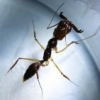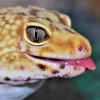Scientific Name: Anoplolepis gracilipes
Common Name: Yellow Crazy Ant, Longlegged Ant
Distribution: Some Polynesian Islands, Australia, and some Asian countries.
Queen size: 15 mm
Worker size: 10 mm
Natural Habitat: Damp rocky outcroppings, crevices, or abandoned Camponotus nests.
Circadian Activity: Slightly more diurnal.
Mating Flight: Random days/months, flies after sundown.
Queen Founding Method: Fully Claustral.
Monogyne or Polygyne: Polygynous.
Average time from egg to worker: (Time varies) Egg to larvae: Around 2 1/2 weeks. Larvae to pupae: Around 2 weeks. Pupae to adult: Around 3 weeks.
Recommended Temperature: During summer this ant prefers warm and humid environments. In the winter the same temperature should be provided.
Recommended Humidity: Not too humid, not too dry. You can mist the enclosure occasionally.
Preferred Foods: Honeybees, crickets, sugar water, honey, other ants
Hibernation Details: N/a
Escape Barrier Methods: I prefer using a lid, but you can use Fluon, oils, or any escape barrier method. They can climb very well, so be careful about how much you use.
Difficulty rating: Moderate, because this ant will eat most insects and is hardy. The only difficult part is founding.
Bite and/or Sting rating: This ant sprays formic acid, but it doesn't spray very much. It only hurts if many ants spray in a mucus membrane or a cut.
Special Care or Interesting Notes: This ant does have formic acid. It rarely uses it, but provide proper ventilation. Also, you can keep Ant crickets if you find them in an established colony. They can help eat leftover food.
Part One: Capturing a queen
Anoplolepis nuptial flights tend to occur only on still, hot, humid nights at around 7:00 with no wind. They will sometimes aggregate in very small numbers around a tennis court light or at gas station lights. Nuptial flights are rare for this species, though, so be prepared to check for these queens at the most random days.
When you see these queens, catch as many as you can of them (leave a few to establish a nest, though). The queens are polygyne and will succeed in numbers.
IMPORTANT! Be sure that you have a Yellow Crazy Ant queen. Yellow Crazy Ant queens resemble Oecophylla Weaver Ant queens and Atta Leafcutter ant queens more than a Camponotus or Pheidole queen.
Part Two: Raising a founding colony
Once you get your queens, try to place them in a test tube with good humidity and make sure there is a good amount of room between the dry cotton and the wet cotton (The reason you keep a good amount of room between the cotton is because Anoplolepis workers are aggressive. If you add food when the workers come, chances are they will run out and squirt formic acid on you). These queens are relatively docile, but they may squeeze out a drop of formic acid if handled roughly.
Their test tubes can be kept in indirect sunlight or lamplight.
Unlike some other species, you can introduce wild worker ants to the nest. The chance that the workers will attack the queens is very low.
When the first workers come, provide good amounts of protein. After they collect enough food, sugar water is necessary.
When there are less than five workers, they can be kept in just a test tube. Once there are more than five, provide an outworld.
Moving a young colony without workers is relatively easy, because the queens probably will carry eggs. In the case that you have to move the brood, you should know that their larvae are mobile. My friend got quite scared when one of his founding colony larvae started thrashing like mad. If you are gentle, though, the larvae will remain calm.
IMPORTANT! Be careful with Anoplolepis workers around your mouth, nose, eyes, ears, or large injuries. Formic Acid is NOT good for mucus membranes and open wounds.
Part Three: Keeping an aged colony
A healthy colony of Anoplolepis is a sight to behold. A colony of these ants can house thousands of workers and many, many queens. Even small nuptial flights may occur in a healthy nest! Maintenance for a large colony, however, is less fun.
These ants need lots of protein and sugar for their lifestyle. Make sure to occasionally provide live food, but feed them dead insects as well. I've learned that Anoplolepis seem to like eating bees that die of exhaustion on tennis courts. Maybe they get the bee's protein and the sugar from nectar in their crop.
If the colony gets too large for their formicarium, try attaching another formicarium (and outworld) to your nest with tubing. If the tubing is well lit, you can artificially bud your colony and have two Yellow Crazy ant colonies at once. Make sure that you only do this if you have two or more queens.
In case of a mite infestation, give your ants orange slices or lemon juice with sugar. They tend to drink/eat sweet citrus faster than sour citrus, and sometimes the time that it takes for your ants to start eating the lemon/sour citrus may be fatal if the infestation is bad.
You can add wild dealate/alate queens or males to your colony to add diversity to the colony. If you want to keep the alates in your formicarium, though, keep the humidity low to prevent nuptial flights. Make sure your formicarium is well ventilated due to their formic acid.
IMPORTANT! Only add your colony to a full formicarium if you have twenty or more workers.
Part Four: Capturing a wild colony
During and after heavy rains, Anoplolepis tend to move nests to adjust according to the situation. It is easiest to catch a queen and some workers after a heavy rain.
After the rain, check walls, rocky outcroppings, trees, and other possible nest sites. You will eventually find an enormous gathering of workers and males, with lots of brood being carried. Wait at that spot for a while and a queen will emerge. My best recommendation is that you should just catch one queen and maybe twenty workers. Let that colony continue in the wild. Also, capturing brood isn't very important because Anoplolepis don't need brood to be comfortable in their nest (Some polygyne ants only lay eggs if there are larvae and pupae around from my experience).
IMPORTANT! Don't use an aspirator to collect these ants. You will get formic acid burns in your throat. Also, the queens and males are quite fragile.
Part Five: Releasing your colony
Sadly, there comes a time when your colony grows too big to care for or you just can't keep ants anymore. The good thing is that this ant can be released very easily, which is more humane than freezing or killing the colony
Try to look for an Anoplolepis colony. Then gently release the workers (and their brood). You can put queens and males in the group of workers. Don't shake or drop the queens or males because they may fly away or get injured.
Try to separate the dominant (fattest, healthiest queen) from the other queens. Get a few workers from the nest along with the dominant queen and make a small nest entrance in moist soil or a rocky outcropping and place your ants nest to there. They can create a new nest there. Don't put a dominant queen with the wild colony because the other colony may kill your dominant queen.
Make sure you release your ants in a place that won't get treated or sprayed with pesticide.
IMPORTANT! Don't release your ants if they are bad invasives in your area.
Information submitted by Hawaiiant
Edited by dspdrew, March 5 2022 - 6:18 PM.




















